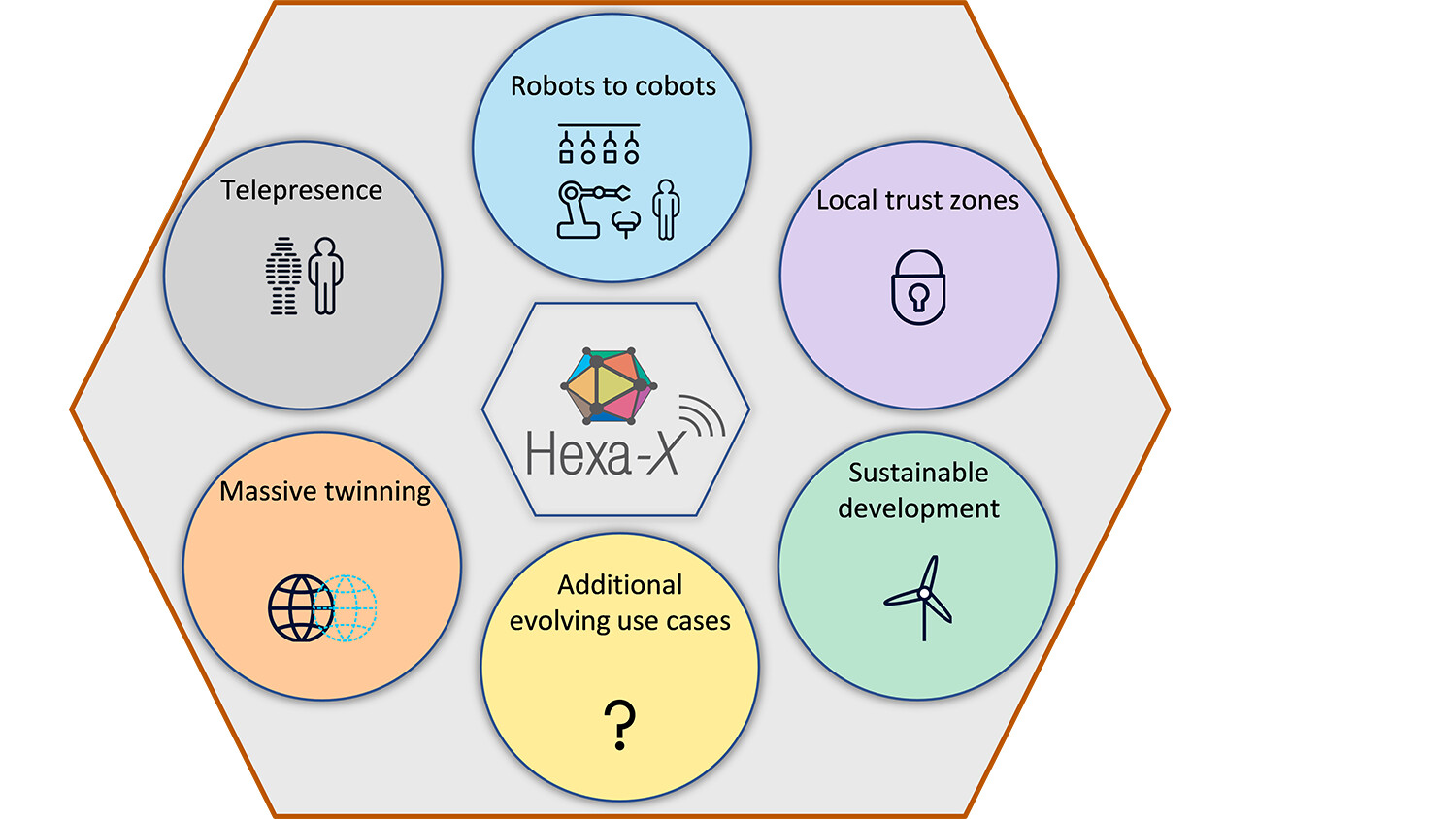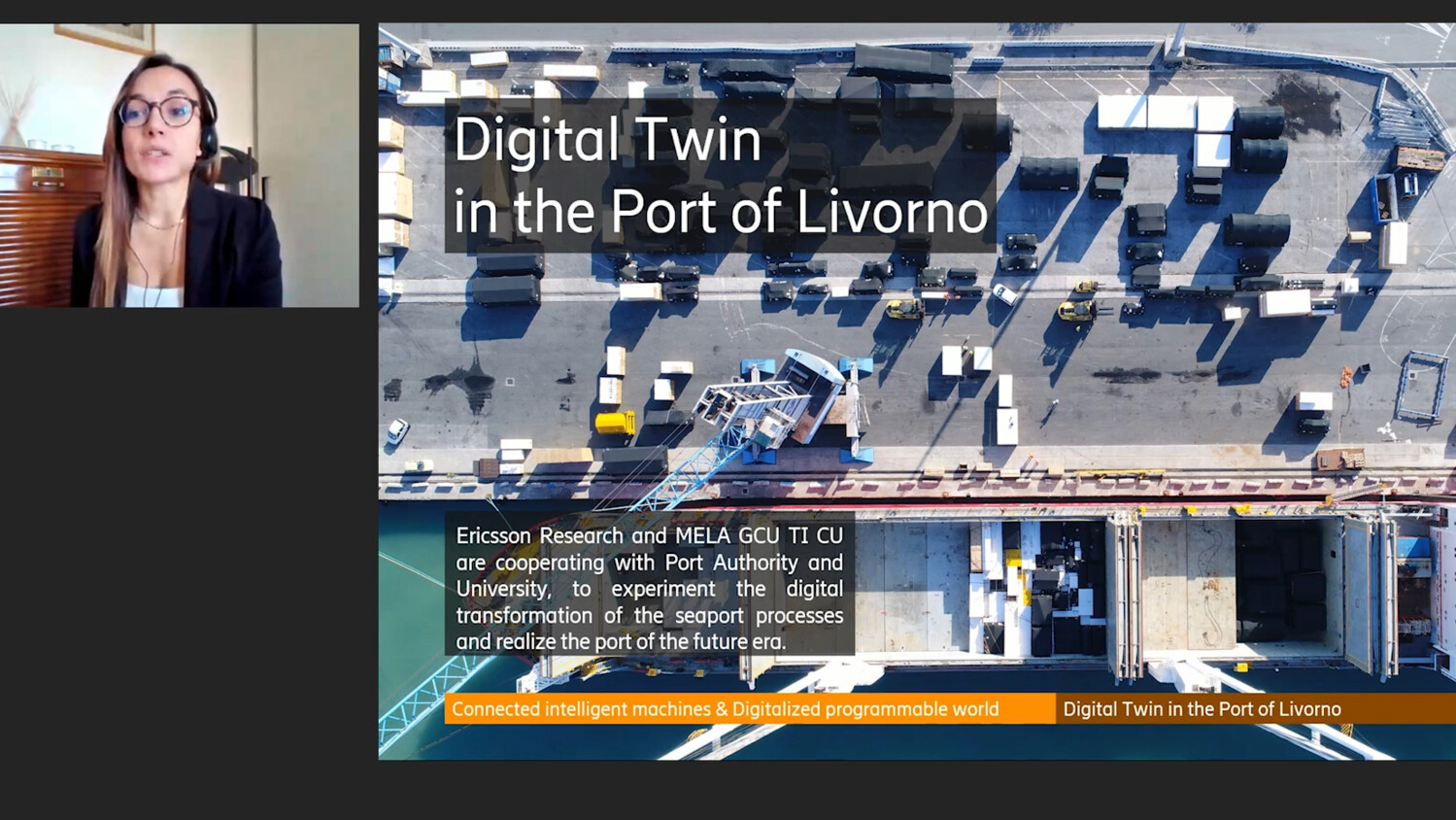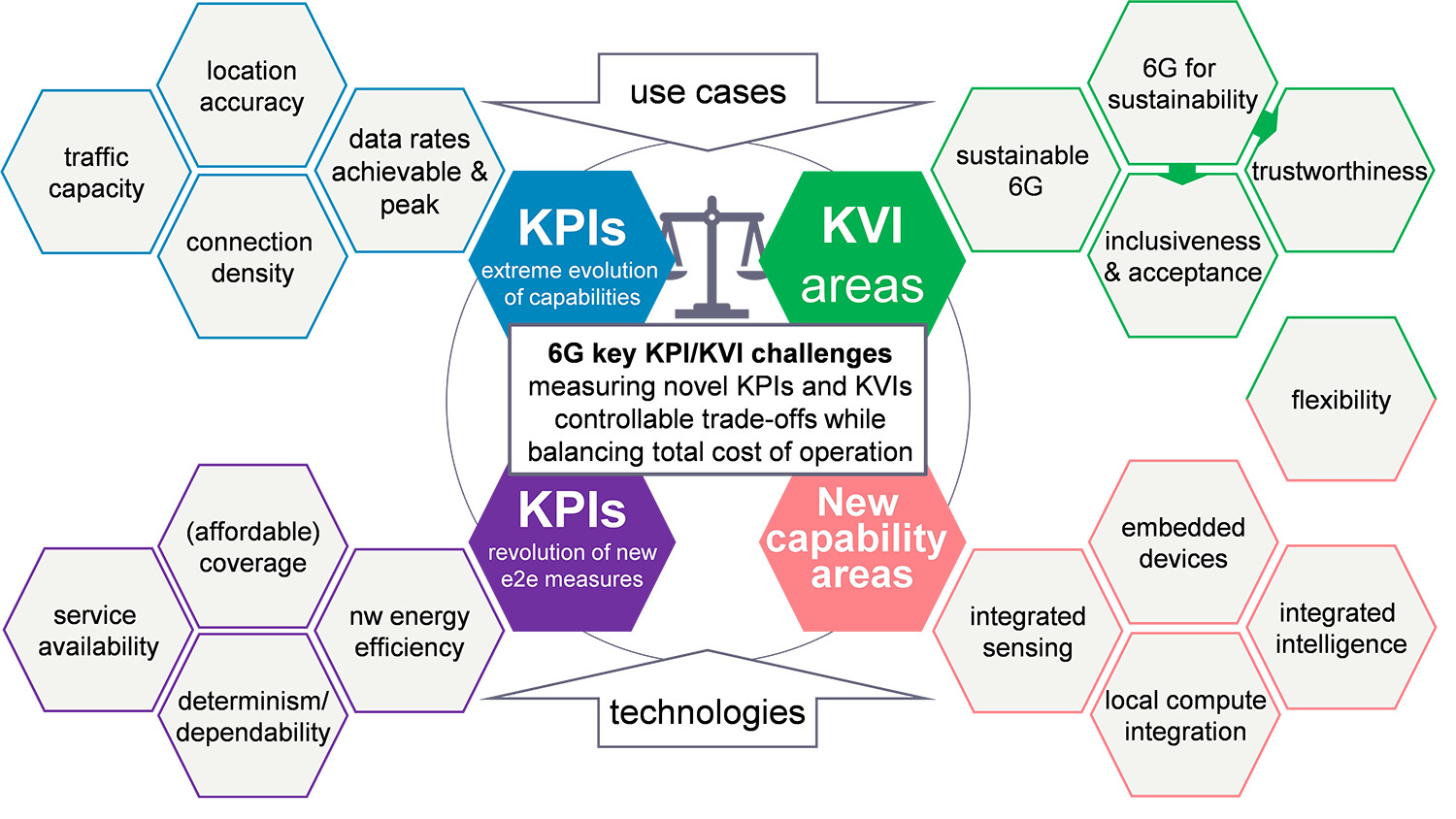Hexa-X: 6G technology and its evolution so far
The vision and ambitions outlined in our previous blog post, Hexa-X – The joint European initiative to shape 6G, have guided the work as we’ve set out to start defining 6G. To lay the foundation, the project has begun by looking at potential 6G use cases and relevant performance metrics, as well as prospective technological enablers with a thorough state-of-the-art and gap analysis described in a first set of deliverables recently released.
6G use cases
The Hexa-X project has identified a plethora of prospective 6G use cases, which can be broadly categorized into five different use case families based on their addressed challenges or prospective technological enablers.

Figure. 1. 6G use case families identified by the Hexa-X project. Source: Hexa-X, D1.2.
These use case families include:
Sustainable development: The novel capabilities envisioned for 6G will provide unprecedented opportunities to enable sustainable development in almost any facet of society or industry, leveraging on the possibility to collect data and actuate responses on a global scale. For example, the use case Earth monitor uses a global distribution of sensors to monitor environmental indicators; E-health for all has a goal to provide global access to e-health even to remote and underprivileged populations; Institutional coverage provides extreme performance to selected institutions in underserved areas; and Autonomous supply chain, can introduce AI/ML on a global scale to help reduce waste in production or logistics chains.
The global reach of these use cases can be facilitated with the incorporation of, for instance non-terrestrial networks (satellites or high-altitude platforms) or wireless backhaul into 6G, while artificial intelligence (AI) or machine learning (ML) functionality can ensure cost-effective data analysis.
Local trust zones: Certain use cases temporarily require extreme performance, for instance in terms of throughput, reliability, or security at levels that are infeasible to deliver with a wide area network. For instance, this could be in precision healthcare scenarios where in-body devices autonomously connect to a local hub which ensure that any confidential data remains local and private; Sensor infrastructure web, where ubiquitous sensors, both onboard and third-party devices are connected, authenticated and where sensor data is verified and integrated into a joint digital representation of the physical world; IoT micro-networks for smart cities, where simple IoT devices autonomously connect to each other to form local mesh networks without the need to densify the network; Infrastructure-less network extensions and embedded networks, where coverage is extended beyond the reach of edge, for example, by multi-hop self-relaying; Small coverage, low power micro-network in networks for production and manufacturing, for example. in a factory where multitudinous IoT devices are interconnected, relying on a locally leased spectrum; Local coverage for temporary usage where e.g. a local program making and special events (PMSE) requires interconnected recording and broadcasting equipment with extreme performance facilitated by, for example, temporary frequency licenses.
To facilitate a cost-effective deployment without necessitating deployment of dedicated custom-built networks, there needs to be possible to deploy a network of sub-networks, where the data and connectivity is kept at a local scale, while the configurations and management can be handled on a macroscopic scale.
Robots to cobots: With the advent of AI/ML and the proliferation of autonomous systems, robots will become much more ingrained in our societies and industries, including both consumer robots in our homes and public spaces, as well as complex industrial robots enabling flexible manufacturing. As their capabilities evolve, they will become responsible for even more complex tasks requiring tightly interacting and cooperative mobile robots (otherwise known as cobots), collaborating both with humans or other autonomous systems while solving to avoid detrimental incidents. Furthermore, many AI systems will exist solely as software, for example, in the cloud, acting as an AI partner assisting the user whenever interacting with a connected device or system.

Hear Elena Fersman, Research Director in AI at Ericsson, discuss the evolution of remote robotics.
Massive twinning: The creation of a digital twin from humans, physical objects, and processes by capturing and modeling the physical world with sufficient fidelity, will allow unprecedented experiences and system insight and control. This includes both an extension of the digital twin concept of industrial processes introduced by 5G, applying the digital twin for manufacturing, but also an expansion to other fields of society. For instance, by applying digital twins to sustainable food production, the health, needs, and ailments of crops and livestock can be monitored in real time, autonomously administering nutrients/food and addressing any threat to increase the yield and reduce the waste.
In addition, it is envisioned that almost any aspect of an entire city could be digitally represented, allowing precise modeling, monitoring, and managing of almost any public or private service, such as utilities, public transportations, public health, or environmental and pollution monitoring for an immersive smart city.

Find out how we’re working with Digital Twins at the Port of Livorno.
Telepresence: To interact with, or experience the physical world remotely with lifelike fidelity will be a commonplace experience in the 2030s. This includes both virtual, augmented, and merged reality, where users can interact with digital replicas of other humans or objects in real time using multi-sensory interactions, extending the audio-visual experience with haptic or even olfactory experiences, creating a fully merged cyber-physical world.
The applications of telepresence will range from passive experiences by streaming content to your local AR/VR devices such as watching a show or presentation remotely, for example, in an immersive sport event, to fully immersive experiences, where your avatar captures and renders your every movement and allows seamless interactions with virtual objects, for instance, playing an immersive multi-player AR game in public, in a merged reality game or co-creating a digital prototype with haptic feedback with remote users enabling mixed reality co-design. This would require your local devices and applications to monitor and react to your local environment to properly position the virtual objects in relation to real objects.
Clearly, the list of potential use cases is far from complete, where some of the current use cases will become significantly more advanced and prominent in 2030, while other use cases will not even be invented until 6G systems are deployed.
Key values beyond connectivity
The evaluation metrics of 6G systems will need to be expanded beyond the classical key performance indicators (KPIs) as it will not suffice to simply design 6G as “X times 5G”.
In the Hexa-X project, we have identified an initial set of essential indicators for 6G. Evaluation metrics relate to different aspects of use cases and network performance, as indicated by the categorization in the figure below.

Figure. 2. Classification of key performance and value indicators proposed by Hexa-X. Source: Hexa-X, D1.2
Extreme evolution of capabilities: As current use cases will continue to be of importance, the performance expectations related to data rates, connection density, traffic capacity or location accuracy will continue to be rise.
Revolution of new end-to-end measures: As the development of use cases continues, it may no longer suffice to suboptimize the network, only focusing on, for example, the air interface performance. Instead, a holistic approach – considering the end-to-end performance related to energy efficiency, service availability, determinism, or coverage, for example – needs to be taken to ensure reliable performance.
New capability areas: As 6G is expected to expand beyond connectivity, novel capabilities are expected to be introduced, such as pervasive integrated compute and AI, convergence of communication and sensing, as well as the embedding of energy harvesting devices. This can enhance the overall performance of the network, and the performance of traditional KPIs, as well as introduce novel domain-specific KPIs.
Key value indicator areas: As 6G is set to become an integral part of society, it will no longer suffice to only consider the technological performance metrics when designing and deploying the system. To this effect, the key performance indicators have been supplemented with key value indicators, encompassing aspects such as inclusiveness and acceptance, trustworthiness and sustainability.
To address the 6G use cases and KPIs/KVIs, the Hexa-X project will study technological enablers for 6G within several different technical areas. For some of these enablers, The Hexa-X project has recently released deliverables covering state-of-the-art and gap analyses, which we’ll now look at. ’ll now look at.
Radio performance towards 6G
Currently, the exploitation of sub-THz frequencies (100-300 GHz) for mobile communications is still in a nascent stage. Considering the challenges imposed by the laws of physics – in other words the generation, propagation, and reception of these frequencies – the design of commercially viable sub-THz communications systems will require a disruptive and holistic approach.
Hexa-X will systematically and jointly study waveform and modulation, radio channel characterization, beamforming and the feasibility of hardware, targeting sub-THz radio design as a part of a 6G system. In particular, waveform and modulation beyond 5G NR will be researched in Hexa-X, which may require adoption in 3GPP standards with respect to 6G air-interface design above 100 GHz.
Apart from wireless communication, Hexa-X will also study the use of mm-wave and sub-THz bands for the development of low-cost, energy-efficient, and high-performance positioning solutions with the precision of <1 cm, while accomplishing unnoticeable delays and having strong privacy awareness. The intent is to make localization and sensing as key features of 6G communication systems by design.
The Hexa-X project recently released a deliverable covering initial radio performance aspects of 6G entitled, “Towards Tbps communications in 6G: Use cases and gap analysis”.
Most notably, the expansion into sub-THz frequencies necessitates a shift in application arising from the associated propagation properties, as well as the larger bandwidths. As such, the Hexa-X project has identified three different classes of use cases applicable to sub-THz frequencies:
- Short range: Both indoor device-to-infrastructure, as well as device-to-device communication, would benefit from the larger throughput while line-of-sight connectivity could be ensured.
- Long range: For fixed wireless links, the unprecedented bandwidths could ensure sufficient capacity for wireless backhauling, while mobile wireless links to non-terrestrial network nodes, such as satellites or high-altitude platforms (HAPs) could provide excellent performance for outdoor coverage.
- Sensing: By repurposing the received signal, the network would be able to infer information about the device location, as well as the surrounding environment with the existing radio interface operating as a radar receiver. As the sensing resolution is proportional to the signal bandwidth, the available bandwidth at sub-THz frequencies can provide much better performance than at lower frequencies. In addition, given the intrinsic frequency dependent reflection of different materials, the sub-THz signals can also be used for inline spectroscopic analysis.

Figure. 3. Key enabling technologies towards Tbps/THz radio communication in Hexa-X.
To address these use cases, the Hexa-X project has started analyzing the requisite technological components. For instance, to achieve throughputs approaching 1 Tbps, the utilized bandwidths necessitate significantly higher bandwidths, which are only available at the higher frequency ranges (e.g. at 100-300 GHz). However, this entails new challenges, for example, hardware performance in terms of achievable output power and noise or propagation channel characteristics in terms of wave-material interactions, atmospheric losses and multipath characteristics.
To address this, the project will evaluate different waveforms and modulation designs, as well as beamforming techniques taking limitations of enabling hardware technologies into account and develop radio channel models for the sub-THz band. In addition, to increase the network density to reduce the propagation distances, the concept of cell-free distributed MIMO will be explored, where the antenna elements of the base stations are distributed in space, instead of placed in large antenna arrays, so that every device or User Equipment (UE) can be served by an optimal subset of the distributed antennas.

Taking 5G to 6G
Discover how 6G can contribute to an efficient, human-friendly, sustainable society through ever-present intelligent communication.
Click here
Connecting intelligence and smart orchestration for 6G networks
An essential tool envisioned for 6G is the application of AI/ML technologies to significantly improve efficiency and service experience for users. This can substantially enhance the cost, energy consumption, trust level and service efficiency of network infrastructure. AI allows networks to adapt faster and more precisely to changing scenarios and traffic demands by acting on predictive orchestration mechanisms in future 6G networks. Network orchestration should incorporate a complete end-to-end perspective in its decisions and enforce actions from devices to RAN disaggregated functions, edge computing, core and cloud elements.
In light of this, the Hexa-X project recently released a deliverable covering the initial analysis of network orchestration and service management for 6G entitled, “Gaps, features and enablers for B5G/6G service management and orchestration”.
There is significant ongoing work to research, develop and standardize automized service orchestration techniques, for example, the 3GPP network data analytic function (NWDAF) or the ETSI Management and Orchestration (MANO), which aims to utilize AI for enhanced performance. In addition, several industry fora and research projects are exploring this topic as well.
Hexa-X aims to explore several aspects of enhanced orchestration, for example, multi-stakeholder or end-to-end orchestration and employing AI/ML techniques such as cross-layer intent-based and network-wide collaboration of AI components. An important aspect for the integration of AI mechanisms will be the prerequisite of explainability to ensure a sufficient level of trust and to be able to identify and address points of failure. In addition, the project will explore several implementation aspects of the service orchestration, such as developing cloud-native functions and exploring enhancements to the orchestration interfaces which can enable the joint optimization of resources and the employment of continuous integration and continuous development (CI/CD) techniques.
Advances in network evolution and expansion
It’s expected that 6G networks will expand into new special-purpose network solutions and towards full worldwide coverage at the same time. To meet these goals, the 6G network needs to be designed to be able to seamlessly integrate a wide range of devices and sub-networks with integrated and distributed AI functionality. To enable this the project will explore for instance device programmability in dedicated networks and streamlined cloud-native radio access and core network architectures which will help to increase deployment and operational flexibility. To expand into new and specialized application domains, special-purpose network solutions need to be enabled with 6G. To expand beyond the digital world towards a fully interconnected fabric, enablers for human-machine interaction and fully immersive digital twins are required.

Figure. 4. Hexa-X use cases related to special-purpose functionalities
The Hexa-X project recently released a deliverable covering an initial exploration of the requirements expected for vertical scenarios for IoT scenarios in 6G called, “Gap analysis and technical work plan for special-purpose functionality”.
In essence, the requirements for the IoT scenarios can be divided into two distinct categories: Sustainable coverage covering use cases such as “Earth monitor”, and “Autonomous supply chain”, “IoT micro networks in smart cities”, and “immersive smart cities”; and dependability covering use cases such as “Collaborating robots”, “Digital twin for manufacturing”, and “Telepresence”.
For dependability, the requirements can be further explained as availability, to ensure the delivery of the required QoS parameters; reliability, i.e., the minimization of the failure rate; safety, avoiding catastrophic consequences of errors or failures; integrity, ensuring the data is not corrupted during communication; and finally maintainability, indicating the time it would take to restore the service in case of failure or maintenance.
For sustainable coverage, the requirements can be further explained as value and cost of generated insights, quantifying the benefits and costs of different coverage solutions in terms of monetary costs, as well as energy consumption and environmental impact; and flexibility, i.e., the ability of existing deployments to adapt to different tasks.
The way forward towards 6G
As shown from these initial deliverables, the work on 6G is ramping up where the research gap analysis points towards the areas to focus on. Additional gap analysis deliverables will be released later this year, covering aspects of Localization and sensing, AI-driven communication and computation co-design, and initial 6G architectural components and enablers. Following these initial reports, the Hexa-X project will steer the work towards explorative research towards technological enablers which aim to close these research gaps to lay the foundation for future 6G systems.
Learn more
Hexa-X deliverables:
Visit the project website
Read our previous blog post on Hexa-X: Hexa-X – The joint European initiative to shape 6G.
Read our research on intelligent digital infrastructure and future network trends.
